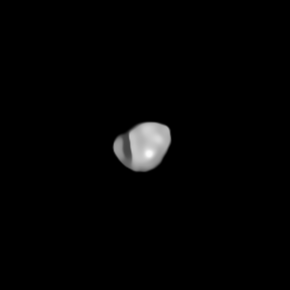Our website is made possible by displaying online advertisements to our visitors.
Please consider supporting us by disabling your ad blocker.
187 Lamberta
 | |
| Discovery | |
|---|---|
| Discovered by | J. Coggia, 1878 |
| Discovery date | 11 April 1878 |
| Designations | |
| (187) Lamberta | |
| Pronunciation | /læmˈbɜːrtə/ |
| A878 GB; 1946 LB; 1948 XR | |
| Main belt | |
| Orbital characteristics[1] | |
| Epoch 31 July 2016 (JD 2457600.5) | |
| Uncertainty parameter 0 | |
| Observation arc | 113.41 yr (41424 d) |
| Aphelion | 3.3856 AU (506.48 Gm) |
| Perihelion | 2.0695 AU (309.59 Gm) |
| 2.7276 AU (408.04 Gm) | |
| Eccentricity | 0.24126 |
| 4.50 yr (1645.3 d) | |
| 217.42° | |
| 0° 13m 7.68s / day | |
| Inclination | 10.588° |
| 21.707° | |
| 196.93° | |
| Earth MOID | 1.0648 AU (159.29 Gm) |
| Jupiter MOID | 1.60306 AU (239.814 Gm) |
| TJupiter | 3.289 |
| Physical characteristics | |
| Dimensions | c/a = 0.86±0.07[2] |
| 141±2 km[2] 130.4±2.7 km[1] 131.3±1.1 km[3] | |
| Mass | (1.9±0.3)×1018 kg[2] (1.80±0.85)×1018 kg[3] |
Mean density | 1.28±0.22 g/cm3[2] 1.51±0.71 g/cm3[3] |
| 10.670 h (0.4446 d) | |
| 0.052 (calculated)[2] 0.0566±0.002[1] 0.0647 ± 0.0135[4] | |
| C[4] (Tholen) | |
| 8.16,[1] 7.980[4] | |
187 Lamberta is a main-belt asteroid that was discovered by Corsican-born French astronomer Jérôme Eugène Coggia on April 11, 1878, and named after the astronomer Johann Heinrich Lambert. It was the second of Coggia's five asteroid discoveries.
The spectrum matches a classification of a C-type asteroid, which may mean it has a composition of primitive carbonaceous materials. It is a dark object as indicated by the low albedo and has an estimated size of about 131 km.[3]
- ^ a b c d "187 Lamberta". JPL Small-Body Database. NASA/Jet Propulsion Laboratory. Retrieved 12 May 2016.
- ^ a b c d e P. Vernazza et al. (2021) VLT/SPHERE imaging survey of the largest main-belt asteroids: Final results and synthesis. Astronomy & Astrophysics 54, A56
- ^ a b c d Cite error: The named reference
Carry2012was invoked but never defined (see the help page). - ^ a b c Cite error: The named reference
Pravec2012was invoked but never defined (see the help page).
Previous Page Next Page


